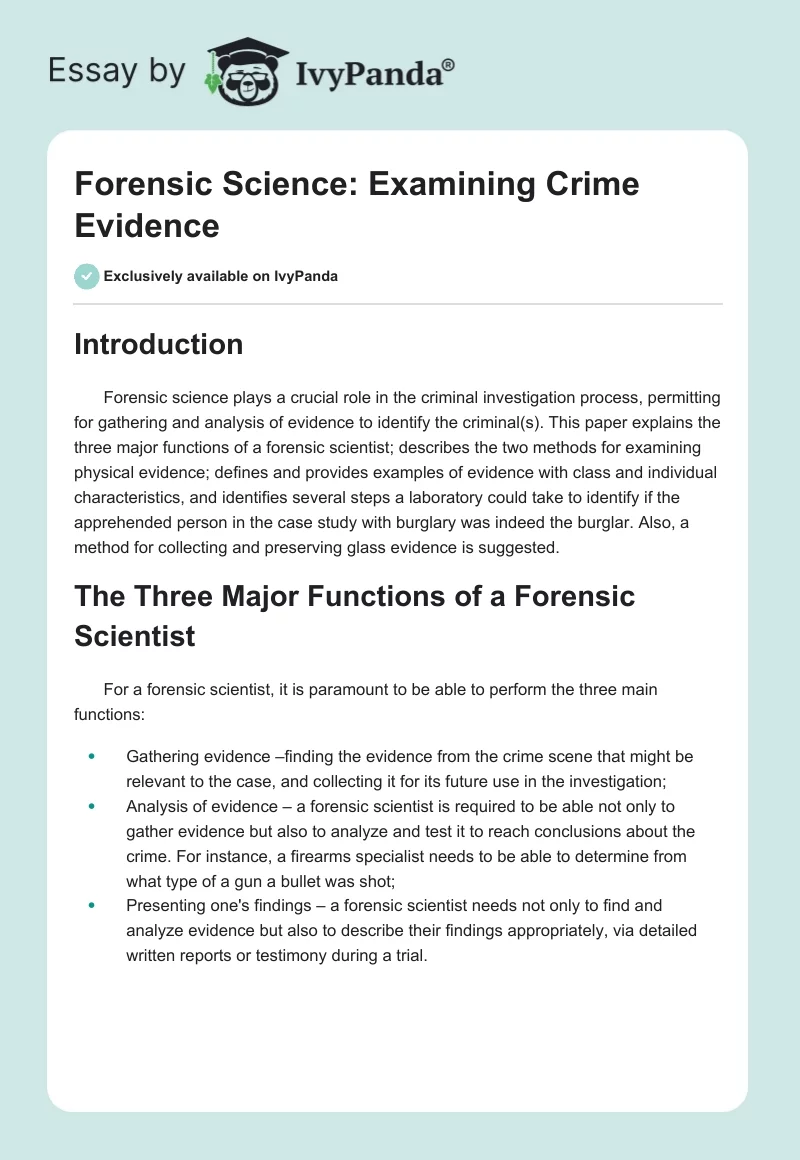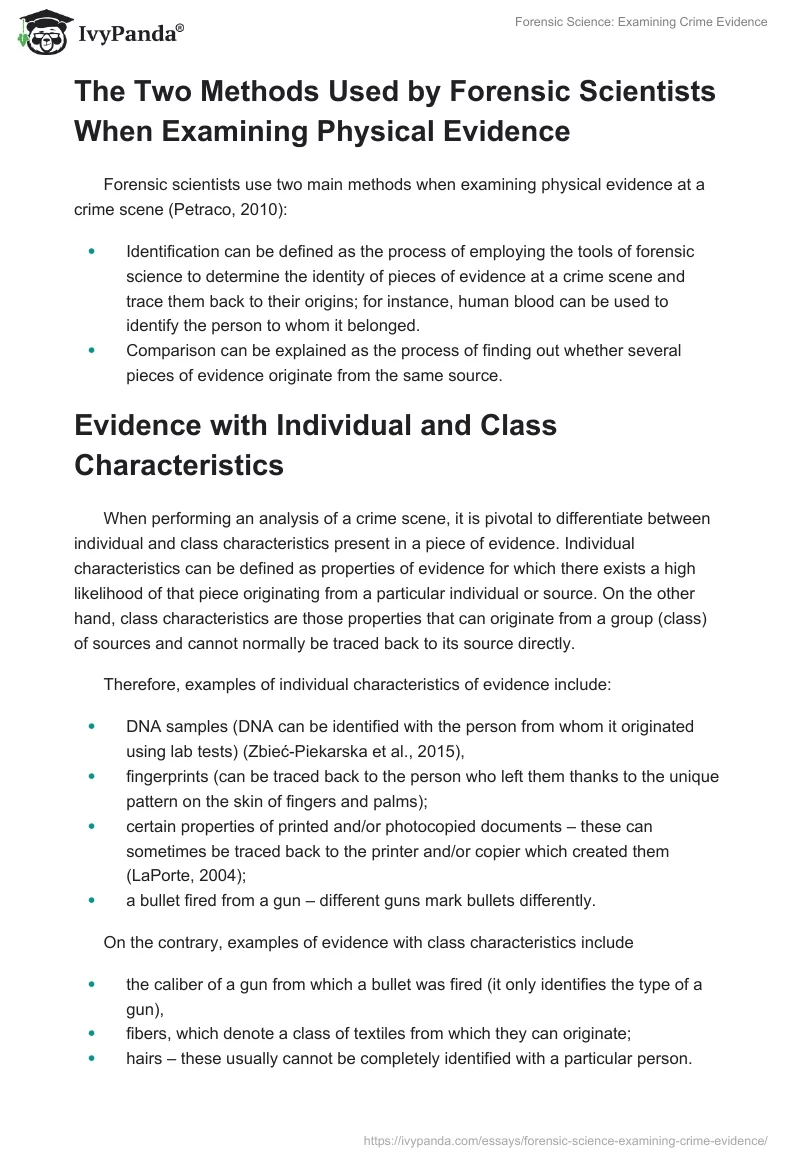- Introduction
- The Three Major Functions of a Forensic Scientist
- The Two Methods Used by Forensic Scientists When Examining Physical Evidence
- Evidence with Individual and Class Characteristics
- Examining and Comparing Evidence from the Burglary
- The Proper Method for Collecting and Preserving Glass Evidence
- Conclusion
- References
Introduction
Forensic science plays a crucial role in the criminal investigation process, permitting for gathering and analysis of evidence to identify the criminal(s). This paper explains the three major functions of a forensic scientist; describes the two methods for examining physical evidence; defines and provides examples of evidence with class and individual characteristics, and identifies several steps a laboratory could take to identify if the apprehended person in the case study with burglary was indeed the burglar. Also, a method for collecting and preserving glass evidence is suggested.
The Three Major Functions of a Forensic Scientist
For a forensic scientist, it is paramount to be able to perform the three main functions:
- Gathering evidence –finding the evidence from the crime scene that might be relevant to the case, and collecting it for its future use in the investigation;
- Analysis of evidence – a forensic scientist is required to be able not only to gather evidence but also to analyze and test it to reach conclusions about the crime. For instance, a firearms specialist needs to be able to determine from what type of a gun a bullet was shot;
- Presenting one’s findings – a forensic scientist needs not only to find and analyze evidence but also to describe their findings appropriately, via detailed written reports or testimony during a trial.
The Two Methods Used by Forensic Scientists When Examining Physical Evidence
Forensic scientists use two main methods when examining physical evidence at a crime scene (Petraco, 2010):
- Identification can be defined as the process of employing the tools of forensic science to determine the identity of pieces of evidence at a crime scene and trace them back to their origins; for instance, human blood can be used to identify the person to whom it belonged.
- Comparison can be explained as the process of finding out whether several pieces of evidence originate from the same source.
Evidence with Individual and Class Characteristics
When performing an analysis of a crime scene, it is pivotal to differentiate between individual and class characteristics present in a piece of evidence. Individual characteristics can be defined as properties of evidence for which there exists a high likelihood of that piece originating from a particular individual or source. On the other hand, class characteristics are those properties that can originate from a group (class) of sources and cannot normally be traced back to its source directly.
Therefore, examples of individual characteristics of evidence include:
- DNA samples (DNA can be identified with the person from whom it originated using lab tests) (Zbieć-Piekarska et al., 2015),
- fingerprints (can be traced back to the person who left them thanks to the unique pattern on the skin of fingers and palms);
- certain properties of printed and/or photocopied documents – these can sometimes be traced back to the printer and/or copier which created them (LaPorte, 2004);
- a bullet fired from a gun – different guns mark bullets differently.
On the contrary, examples of evidence with class characteristics include
- the caliber of a gun from which a bullet was fired (it only identifies the type of a gun),
- fibers, which denote a class of textiles from which they can originate;
- hairs – these usually cannot be completely identified with a particular person.
Examining and Comparing Evidence from the Burglary
After the suspect with specks of glass on his clothes and shoes were apprehended, steps that a crime laboratory could take include:
- Comparing the fingerprints of the suspect with those found in the crime scene (if they were found);
- Calculating the density, refractive index, and other similar properties of glass found on the suspect’s things (and probably the fracture patterns, if the specks are of sufficient size), and comparing them to these of any broken glass found at the crime scene (Bertino & Bertino, 2012);
- Comparing the fibers in the suspect’s apparel, at his home, etc., with those found at the crime scene;
- Examining whether the patterns in the broken glass from the crime scene could have been inflicted by the suspect (e.g., if he is tall/strong/etc. enough to break the glass in the given way).
The Proper Method for Collecting and Preserving Glass Evidence
It is crucial to properly handle the glass evidence from the crime scene to avoid their contamination or loss (Bertino & Bertino, 2012, p. 408):
- Before moving any samples of glass, they should be photographed;
- The largest fragments that can be “reasonably collected” should be gathered (Bertino & Bertino, 2012, p. 408);
- The inside and outside surfaces of the pieces of glass found in the crime scene should be identified;
- The relative positions of window panes should be captured using a diagram if several such panes are involved;
- Other types of evidence (e.g., blood, hairs, etc.) should also be identified if they can be found on the pieces of glass;
- All the collected pieces of glass should be packaged appropriately to keep the chain of evidence as required.
Also, the collected pieces of glass need to be separated based on their physical properties, such as color, texture, or size; separate pieces should be cataloged and stored separately, e.g. so that contamination does not occur (Bertino & Bertino, 2012, p. 408).
Conclusion
On the whole, it should be stressed that the implementation of forensic science allows for considerably increasing the rate of solved crimes. It is paramount to know it and use its principles if the numerous crimes occurring nowadays in the world are to be successfully solved.
References
Bertino, A. J., & Bertino, P. N. (2012). Forensic science: Fundamentals and investigations. Boston, MA: Cengage Learning.
LaPorte, G. (2004). The use of an electrostatic detection device to identify individual and class characteristics on documents produced by printers and copiers: A preliminary study. Journal of Forensic Sciences, 49(3), 1-11. Web.
Petraco, N. (2010). Color atlas of forensic toolmark identification. Boca Raton, FL: CRC Press.
Zbieć-Piekarska, R., Spólnicka, M., Kupiec, T., Makowska, Ż., Spas, A., Parys-Proszek, A.,…Branicki, W. (2015). Examination of DNA methylation status of the ELOVL2 marker may be useful for human age prediction in forensic science. Forensic Science International: Genetics, 14, 161-167.


